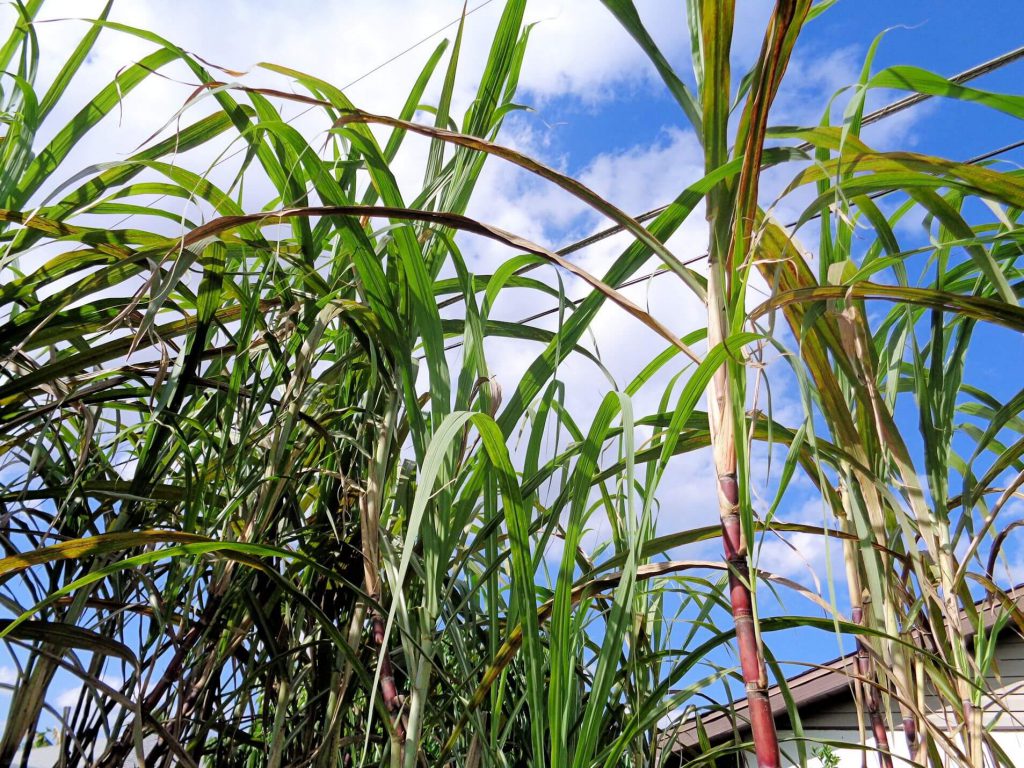 Tired of growing St. Augustine and Bahia grass? Why not try a tropical relative that you can actually eat – sugarcane! Many homeowners already have this perennial tropical grass growing happily in a corner of their lot. It is hard to imagine, but, if everything goes well, a “seed-piece” of sugarcane planted in the garden will produce a two to four pound stalk with fifteen percent sugar content in about twelve months! Careful attention to planting and growing sugarcane will reward your sweet tooth with a special home-grown treat.
Tired of growing St. Augustine and Bahia grass? Why not try a tropical relative that you can actually eat – sugarcane! Many homeowners already have this perennial tropical grass growing happily in a corner of their lot. It is hard to imagine, but, if everything goes well, a “seed-piece” of sugarcane planted in the garden will produce a two to four pound stalk with fifteen percent sugar content in about twelve months! Careful attention to planting and growing sugarcane will reward your sweet tooth with a special home-grown treat.
I first tried growing sugarcane from a piece I picked up on vacation in Florida as a youth. It did not amount to much up north on my windowsill! My next experience with sugarcane was as a young man in the West Indies where fresh-squeezed cane juice and chewing cane was an abundant treat. I now grow it in my yard strictly for chewing which is a delightful luxury! Sugarcane is generally classified for the purpose of chewing, for crystals or for syrup. Chewing-types contain fibers that stick together so that they are easy to spit our once chewed. Sugarcane for crystals generally has a high sucrose level that will better form crystals. Syrup types have less sucrose which allows better formation of syrup instead of sugar crystals. Besides selecting a favorite cane variety grown by a friend or neighbor, there are a few named varieties that can be acquired. For instance, ‘Yellow Gal’ and ‘White Transparent’ are good chewing types. Crystal-forming sugarcane can be produced with any commercial variety grown in Florida. Syrup types may include ‘Louisiana Ribbon’, ‘Louisiana Purple’ or ‘Louisiana Striped’. Sugarcane can also be considered ornamental as some cultivars have purple canes, others are striped purple and green – some even have variegated foliage.
You start sugarcane with “seed pieces”. Seed-pieces are vegetative sections of cane which grow best when two to three feet long with about six buds per piece. Sugarcane is a hybrid and will not come true from seed. Position your sugarcane patch in an area that passers-by will not brush up against the sharp sugarcane leaves. Full-sun is best in a well-drained soil that has been worked up to receive the extensive root system. Cane can be planted almost anytime during the warm growing season. Rows should be about five feet apart. Prepare a furrow at least eight inches deep and apply one pound of 8-8-8 per ten feet of furrow. Cover this layer with two inches of soil and then lay the seed piece in place. Cover this with another three inches of soil. Keep the patch moist, but not wet so that rots do not set in. Established cane will tolerate temporary wet conditions. As the new shoots emerge, fill in the furrow until it is slightly mounded.
Harvest your cane any time after November first – but before a freeze. Don’t harvest too early as yield will be affected. Cut the cane as close to the ground as possible. Most of the sugar will be found in the lower part of the stem. Trim off the green section of the stem and cut up into small pieces for chewing or squeeze into juice for processing. Then, enjoy your very own backyard sweet treat!
For more information on all types of edible tropical and subtropical plants, please call our Master Gardener volunteers on the Plant Lifeline on Mondays, Wednesdays and Fridays from 1 to 4 pm at 764-4340 for gardening help and insight into their role as an Extension volunteer.
Just as a reminder, we have moved to our new office at the North Charlotte Regional Park at 1120 O’Donnell Blvd, Port Charlotte FL 33953.. Our phone numbers and email addresses will remain the same. Don’t forget to visit our other County Plant Clinics in the area. Please check this link for a complete list of site locations, dates and times – https://sfyl.ifas.ufl.edu/media/sfylifasufledu/charlotte/docs/pdf/Plant-Clinics-Schedule1.pdf. Our Eastport Environmental Demonstration Garden is always open to the public outside the gate at 25550 Harbor View Road. Master Gardener volunteers tend this garden on Tuesday mornings from 8 to 10 am and are available for questions. Ralph E. Mitchell is the Director/Horticulture Agent for the UF/IFAS Charlotte County Extension Service. He can be reached at 941-764-4344 or ralph.mitchell@charlottecountyfl.gov.
Resource: Baucum, L., Rice, R.W & Muralles, L. (2009) Backyard Sugarcane. The University of Florida Extension Service, IFAS.
 1
1
